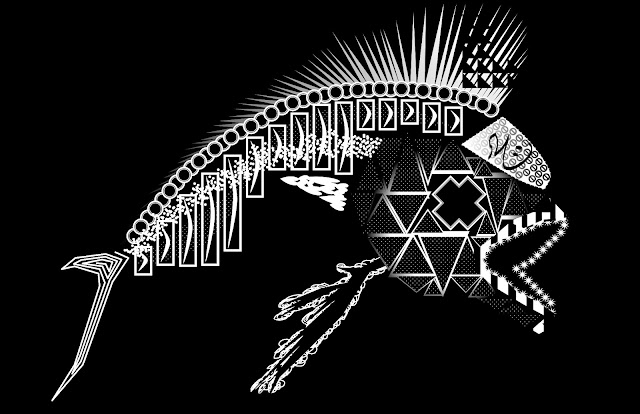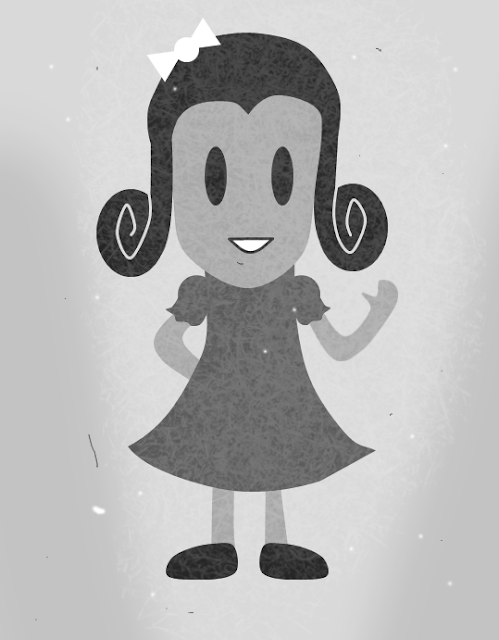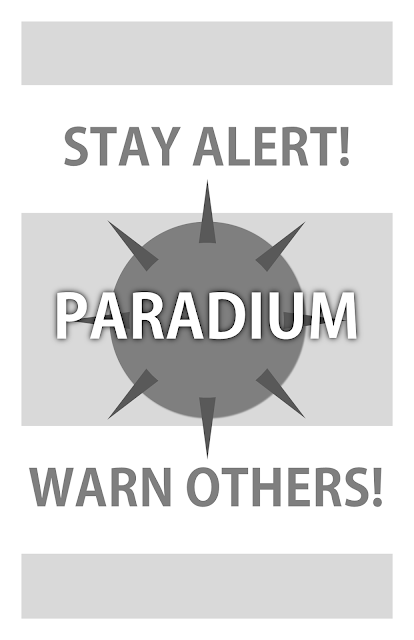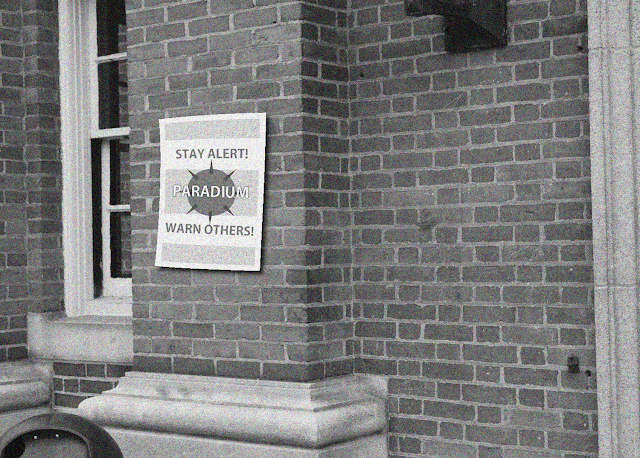The machine beeped again. The beeping was entirely random,
happening at some point during an interval of four minutes. It was difficult to
keep track of the four-minute cycles, as the beeping could take place at any
point during the duration, not necessarily at the beginning or end. Sometimes a
beep came almost immediately following another beep, and Keiger knew then that
the cycle had just begun anew. He tried not to keep track of the cycles,
though. Keiger thought that that would be hurtful to the machine should it ever
learn that he was wary of it.
He needn’t
have worried, but since worrying seemed to be inevitable for him, he should
have worried about more important matters. The machine was a simple random
number generator, assessing a myriad of vibrating particles in tiny, two-sided
tubes to determine whether each was at one end or the other in a binary
function which gave it two values to work from. The first was the millisecond
value that would be assessed to determine at what point during the four-minute
interval the beep would sound. For instance, should the value be 15000, the
beep would occur a minute and a half into the cycle, and if it was a negative
of the same number, the beeping would occur two and a half minutes into the
cycle. The second was a far more specific function. Every time the beep
sounded, the machine would add together all the values of the particles,
positive and negative. If, at the instant of the beep, the value were to equal
exactly negative ninety-two, the machine would expel from itself a volley of
knives in an array specifically designed to kill Keiger almost instantly with
no chance of escape. There was no danger of the machine beginning to distrust Keiger,
but certainly, there was danger present.
“Ah, I see you’ve beeped again. That’s
wonderful, isn’t it?” asked Keiger of the machine. “It lets me know that you’re
still doing well, still fit and fine.” Keiger shifted awkwardly in his seat. At
his feet lay a knife, which he had thrown on the ground as a sign of his trust
in the machine. You see, the machine received its power through a large wire
which lay about on the ground in front of it. One determined swipe from Keiger’s
own knife would have saved him from a multitude of knifes moving in the
opposite direction.
Keiger eyed
the knife with what he thought would be perceived as a demeanor of distaste.
“An odd situation we’re in, wouldn’t you say?” said Keiger, still eyeing the
knife in a manner that he thought the machine would appreciate. “I know you
could kill me whenever you wanted, but the fact that you could have all this
time and chose not to is really appreciated. I just want you to know, I have no
intent of killing you. Let’s just continue to enjoy each other’s company,
alright?”
The machine
did not respond, but silently began its cycle anew and decided that the next
beep would occur in three minutes and twenty-eight seconds. The apparent
silence unsettled Keiger. “I know you must be nervous, but it’s okay. I’m a
very non-violent person, and I would never kill someone. Besides, I barely know
you. I’m sure that you’re really very interesting.” Both Keiger and the machine
sat in silence for a moment. A beep sounded, and the machine quickly counted a
number of vibrating particles. The number it arrived at was three hundred and
four. The number not being negative ninety two, the machine erased it from its
memory. Keiger breathed a silent sigh of relief when he saw that no knives were
flying from the machine.
“They want
us to kill each other, you know. I have no idea why, but they’re under the
impression that one of us needs to die soon. Well, we’ll show them, eh? We
could just as easily sit here peacefully like any two normal, rational people.”
The machine
beeped, and for the first time since his imprisonment Keiger felt a sense of
communication between himself and the machine. “That’s right! Who do they think
they are, handing us knives and expecting us to fight like animals?” Keiger
picked his knife up off the ground and waved it about in a mocking manner. “We
really don’t need these, anyway. What purpose do they serve? To anyone else
they might be tools, but between us they are weapons of murder! I’ll gladly
cast mine aside. I just sort of wish you would do the same.”
Keiger shuttered when he
realized what he had said. “No, no, I’m sorry! I didn’t mean to say that! It’s
not that I don’t trust you with your knifes; I know you don’t want to hurt me. I just…” Keiger
struggled to find the right words, fearing with each passing second of the
four-minute cycle that the machine would become offended and decide to kill
him. “I guess I’d just feel better about everything if we were both unarmed,
you know?”
Keiger shifted uncomfortably in his
seat, the knife still dangling in his limp wrist. After an unusually long
silence, the machine beeped. Keiger looked up hopefully. “You agree? I knew you
would. You’re so understanding. I mean, if either one of us has a knife, it’s
just going to end with one of us stabbing the other.”
Keiger
scanned the machine and found the covered ports where the knives were meant to
be fired from. He looked down at his own knife. Slowly, while keeping his eyes
on the machine, he began to rise to his feet. He took a tentative step forward,
grasping the knife with uncertain resolve.
The machine beeped. Keiger
stiffened instantly, “No, it’s alright! I’m not going to kill you!” The covered
knife ports remained covered. Keiger relaxed. “It’s okay. I’m just trying to
disarm you. Don’t worry about it.” He took a few more uneasy steps forward, and
found himself standing mere inches away from the multiple points from which
death could fly swiftly towards him at any moment. The panels themselves were
sunken into the face of the machine, about four inches square, covered by a
metal plate which extended an inch beyond the external frame of the port.
Keiger took all this into account.
Prying the cover plate off would be impossible, that much was clear. He looked
into what he perceived to be the face of the machine, though no such thing
existed. “I think I’d need to puncture these doors. I don’t know if it will
hurt you, but you have to understand, it’s the only way I know to disarm you.
Is that okay?”
The machine gave no response.
Keiger stared down at the knife in his hand for what seemed like an eternity,
and finally brought it level with the knife port closest to him. He placed the
tip gingerly against the corner of the frame, so that it was perpendicular with
the metal covers surface. Pausing once more to listen for the voice of the
machine, Keiger forced his eyes shut and thrust the knife as hard as he could
against the knife port.
A metallic click was heard. Keiger
opened one eye. The sheet of metal guarding one of many unfired knife
projectiles showed no sign of having been touched. The knife in Keiger’s hand
had slid across the surface of the port and slammed against the side of the
frame, not having even scratched the surface. On the floor by Keiger’s feet lay
the tip of his own knife, broken free by the impact.
Shaken, Keiger made his way back to
his seat, his knife hanging broken and limp against his side. The machine
beeped. Keiger nodded. “I guess that didn’t work out too well, now did it?” The
machine arrived at the number seven and counted off the rest of its four minute
cycle in silence, leaving Keiger to run some silent calculations of his own. He
knew that the machine was a random number generator with no personality, with
no free-will of its own. He knew that it could not hear his friendly banter,
nor did it feel the knife sliding across its port. But he also knew that no
number was truly random. There were always outside factors to consider, and
without knowing what those factors were, Keiger could only act in the manner
which he believed would be most favorable to whatever unseen forces were
holding the projectile knives in their place.
“You… you can’t hear me, can you?”
The machine said nothing in
response, having decided one minute prior that its next beep would sound in two
minutes and twenty seven seconds. Keiger noted the silence, “I mean, all you do
is come up with numbers and shoot knives at people. Do you like either of those
things?”
The machine, of course, had no
strong opinions one way or the other. Keiger sorted his thoughts, trying to
find the words to what he hoped was the solution. “You don’t like those much,
do you? I know you must not like killing, as we’ve been here for quite some
time and you have yet to kill me. And it must get so tedious, having to deal
with all those numbers all the time.”
“What if…” Keiger began, trying for
all the world to sound as though the idea was just occurring to him, “what if…
you didn’t have to do either of those things anymore? What if you just
stopped?”
The machine had thirty one seconds
remaining before it would beep. In the interior of the machine, hundreds of
tiny tubes vibrated in their place, sending the particles within bouncing from
one end to the next, back and forth, positive and negative. Near the surface,
several dozen knives were loaded just under their respective knife ports, poised
like bullets in a gun, awaiting the count. Keiger pretended to notice none of
these things, and continued to state his position. “Well, you know, both of
those things would stop if I were to just cut your power intake. That’s all it
would do. You wouldn’t need to die, just rest for awhile. Would that be alright
with you?”
There was no signal, nothing that
could be interpreted by anyone as an affirmative or a negative. Keiger held his
broken knife in his right hand as he stooped to the ground and picked up the
thick input wire in his left. He held the wire against the blade of the knife,
the soft rubber coating marked already by the meager pressure Keiger exerted
from his shaking hand. He looked up at the machine. “I’m sorry.”
The machine beeped. Keiger froze
where he kneeled, his arm becoming too tense to move. He dropped his knife beside
his trembling legs, which had begun to spasm. Blood seeped from his mouth, and
he found himself unable to cough or breath. The blood had begun to pool just
under his tongue when he fell forward, his elbows no longer able to support his
weight. The uncut wire pressed against his blood-soaked side, and a knife with
a broken tip was engulfed by a puddle of blood, slowly advancing from Keiger’s
body.
The machine
closed its empty knife ports and cleared the number negative ninety-two from
its memory. It then began to wait out the remaining one minute and twenty three
seconds before deciding the time when if would next beep.



















